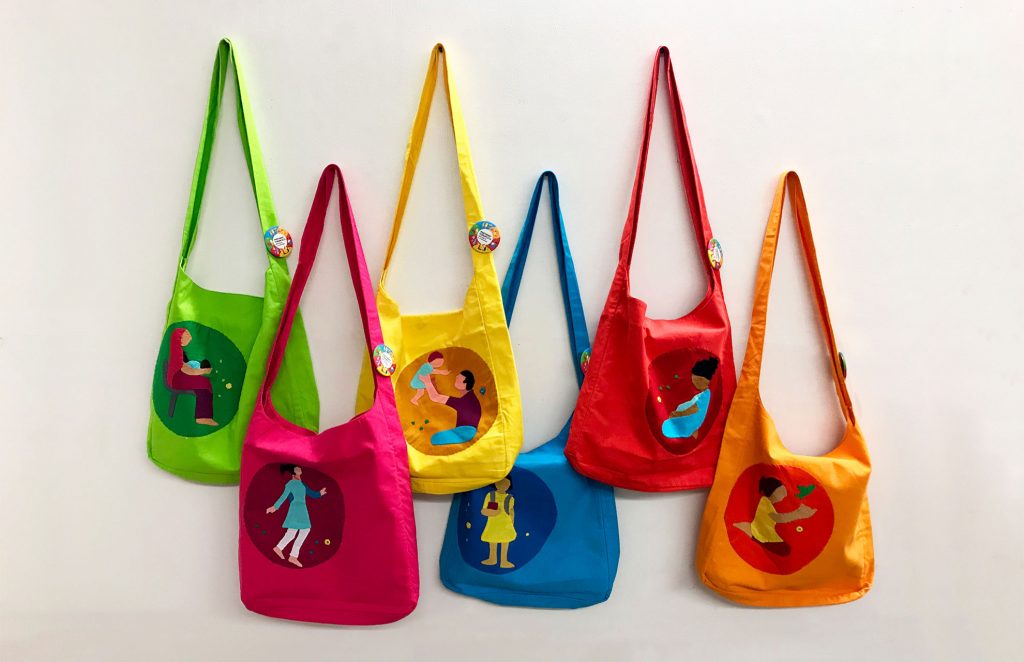Meaning
The word ‘appliqué’ is derived from French word (verb) ‘appliquer’ and Latin word ‘applicare’, which means to join, attach, cover or put on. It is a leg of textile art and craft, where cut-out pieces of fabric are sewn (using various stitches) onto to a larger base or background fabric to form decorative patterns. Rudimentary tools and materials like cloth pieces (cotton or voile), needles, threads (cotton or nylon), scissors, wires, markers, chalk, mirrors, metal pieces, cords, tapes, laces, ribbons, and sewing machine are used. Note: It differs from patchwork, which is a process of stitching small pieces together to form a larger whole (fabric in itself).
History
Ancient civilisations like Egyptian, Mayan, Chinese and others used it. Nomadic tribes in all continents made furnishings and tents, and some of their daily-use items using appliqué. During the Middle Ages, heraldic and religious banners and ceremonial clothing flaunted this art. And traditional clothing in the 12th to the 19th centuries, across geographies used this form extensively, too. For centuries, in India, appliqué has been adopted and adapted by a number of states like Rajasthan (Barmer, Jodhpur, Ranthambore and Jaisalmer), Gujarat (Kutch and Kathiawar), Bihar, Himachal Pradesh (Kangra and Chamba), Karnataka, Uttar Pradesh, and Odisha (Puri and Pipli). With time, each region developed its own distinct style with identifiable patterns and colours.
Variations
There are a number of variations of appliqué and these usually are manifestations of anthropology, culture, religion, climate and use. Sometimes appliqué is used as part of a larger surface ornamentation. For instance, a type of Persian embroidery (broderie perse) involves appliqué using chintz (printed cotton). Here cut-out printed fabric motifs are arranged into a pattern. Then you have the reverse or inlay appliqué, where the top fabric is cut, finished and layered to expose the lower one. Three-dimensional appliqué is another variation, where surface of the background fabric is raised and extended using complex constructional techniques. Last but not the least is its use in textile art—part of mixed media to depict concepts.
Motifs
Geometric shapes, abstract design, schematised stories and iconography dominated old-world appliqué designs and they still do so. Nature and its basic design always played a role. So did alternative and underground fashion aesthetic. Contemporary designs are stylised motifs of abstract, graphic, pop, flora and fauna, and mythical figures. Stitches like running, chain, stem, hem, knot, tag, ruching, back and buttonhole are used to hold these motifs down on the fabrics. However, the designs used for religious purposes usually maintain their sanctity, while the ones used for common use are derived from the mundane-ness in the crafter’s surroundings. The common process to develop any kind of motif is designing, tracing, cutting, tidying pasting, stitching and finishing.
Fashion
Then comes the use of this art in daily and high fashion. The 50s Irish dance competitions made the poodle skirt pretty famous. It was a knee or bellow knee-length, felt circle skirt with a large poodle (dog) appliqué. The hippies (Flower Children) in the 1960s took appliqué to another level with larger-than-life, pop-coloured floral designs. Couturiers like Elsa Schiaparelli, Bob Mackie, Christian Francis Roth Franco Moschino, Koos van den Akker and even Gianni Versace are till date known for their art-like appliqué explorations.
Pipli’s narrative
Temple rituals and processions of Lord Jagannath, Lord Balabhadra and Devi Subhadra (started during 12th century) in Puri are the root of this craft in Odisha. From canopies, banners to umbrellas, all have appliqué designs. Think traditional Tarrasa (fan; a heart-shaped wooden piece covered by appliqué cloth and supported by a long wooden pole), Chandua (an umbrella-shaped canopy) and other decorative frills and attachments used during Rath Yatra (annual chariot procession of the Gods). Social, natural, astral, mythological stories inspire the presence and placement of motifs like phula (flower), gacha (tree), surjamukhi (sun), haathi (elephant), sua (parrot), mayura (peacock), maccha (fish), belapatra (leaf of bel tree), bataka (duck) are famous. Pipli, a village about 40 kilometres from Bhubaneswar, is now known to commercially retail products boasting this handicraft. You will find a range of items like wall hangings, bedspreads, tablecloths, bags, purses, lamps, cushion covers, bolster covers and quilts at affordable prices.
S Bhavana
